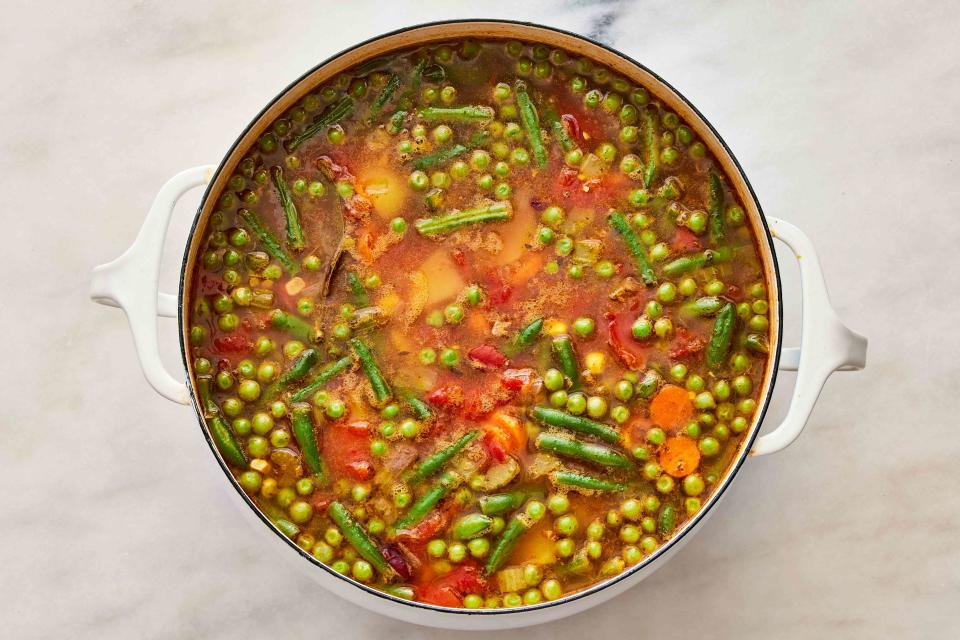How To Fix A Dish That's Too Salty: 6 Easy Ways
Six easy ways to quickly fix salty food.

Morgan Hunt Glaze, Food Stylist: Jennifer Wendorf, Prop Stylist: Shell Royster
There might not be anything more disappointing than spending an entire day preparing a meal, only to sit down and realize that it has been over-salted. Perhaps too much salt was added unknowingly, or worse – the lid to the salt fell off mid-pour and dumped half the container directly into your meal.
However it happened, figuring out ways to quickly neutralize salt in food may be a top priority, particularly if you're getting ready to serve a crowd and salvage your meal. Here are six quick fixes for making food less salty, as well as tips from a registered dietician for cooking with salt.
Meet The Expert
Chelsea Edwards is a registered dietitian and the owner of Huntsville Nutrition Collective in Huntsville, Alabama
6 Ways To Make Food Less Salty
Yes, it's possible. When at-home chefs have over-salted a meal, making food less salty–by removing sodium or neutralizing the food–is a priority.
“When you add salt at the beginning of cooking, the salt penetrates the food and makes it taste salty throughout,” says Chelsea Edwards, a registered dietitian. “When you salt food at the end, the food will have a more concentrated salt flavor that is sensed immediately.”
Meet The Expert
Chelsea Edwards is a registered dietitian and the owner of Huntsville Nutrition Collective in Huntsville, Alabama.
Scoop out the salt.
If over salting is a result of an accidental dump thanks to a loose cap, try scooping away the salt to salvage the recipe. If it’s a soup or liquid dish, use a spoon to gently remove excess salt. If it’s a piece of meat, wipe away excess salt and pat the meat dry using a paper towel.
Add an acid to the recipe.
Adding an acid, like lemon juice, can balance an abundance of salty flavor in food, but be careful of adding too much and destroying flavors. “You can add something acidic, such as lemon juice, lime juice, apple cider vinegar, or processed tomato products to foods to reduce the salty flavor,” says Edwards. “This doesn't reduce the sodium intake, but it does reduce the perception of the salty flavor.”
Use dairy.
The fat found in dairy can create a barrier by coating your tongue’s taste buds, which helps to neutralize the salt. Dairy products to consider for use in recipes include: heavy cream, cream cheese, milk, sour cream, mayonnaise, and soft cheeses.
Increase the recipe.
This tactic might be a reach if you have purchased just enough ingredients to create your meal, but if there are extra ingredients, use them to increase the recipe and balance the salty flavor.

Toss in potatoes.
Raw potatoes can absorb liquid and the salt in the liquid, reducing the immediate perception on the tongue of salt. “It helps by reducing the immediate salt flavor you would get by redistributing it through the potato,” explains Edwards.
Sprinkle in sugar.
Believe it or not, a spoonful of sugar helps the recipe get balanced. Adding a pinch of sugar can help to balance and neutralize an over salted dish. When adding sugar to any recipe, be sure to add just a small amount at a time, stirring thoroughly, and doing a taste test before adding more.
Tips For Making Food Less Salty
Edwards says that the best way to make food less salty is to add the salt at the end as a finishing salt, rather than early in the cooking process. "This increases the perception and sensation of salt when you eat the food, rather than having salt absorbed throughout all the food you're eating," she says.
Drain and rinse canned goods to reduce some of the sodium content.
Umami substances such as glutamate, inosinate, and guanylate can be used in place of salt to add a savory flavor, which often reduces the need for salt in foods to make them palatable.
Make sure to use the correct salt (table, Kosher, sea salt, etc) while cooking.
Related: Everything You Need To Know About Different Types of Salt
For more Southern Living news, make sure to sign up for our newsletter!
Read the original article on Southern Living.

